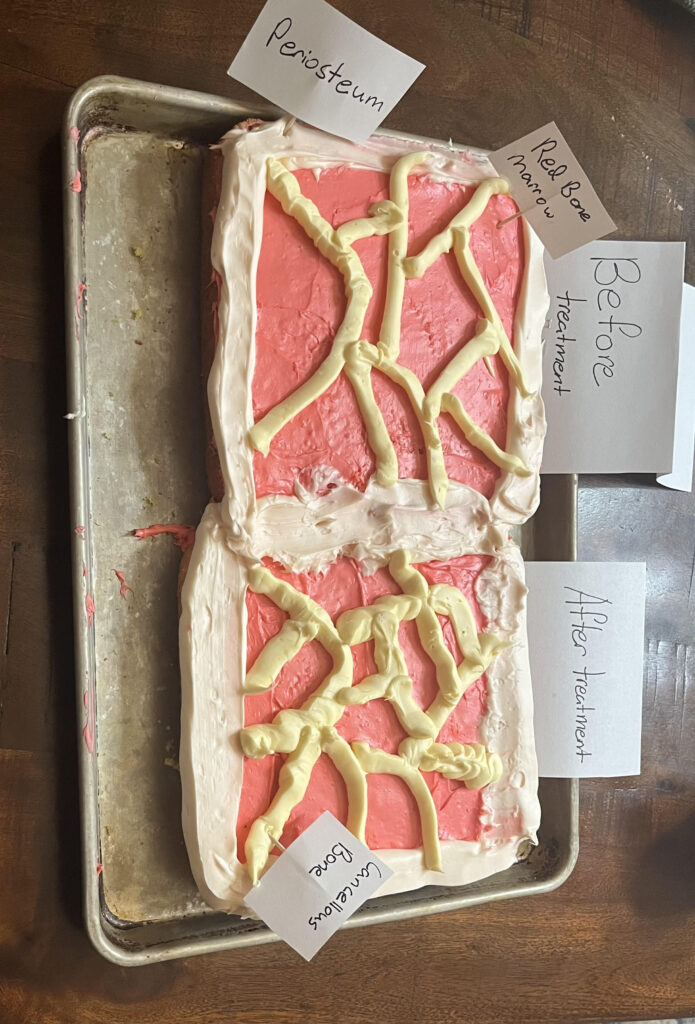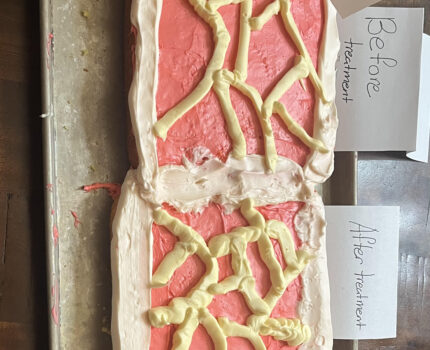In my steam project I am going to be looking at Osteoporosis and the effects it can cause on human bones. The effects that I will be looking at are going to be compared and contrasted to normal functioning bones. My art project will be creating two cake models of bones, one is human bones affected by osteoporosis but treated and the other one is going to be bones that are affected by osteoporosis.
The effects of osteoporosis changes the roles for bones, bones are supposed to be able to protect , support, movement, and hormone production. These all are affected due to osteoporosis. Osteoporosis is most common in older white women post menopause due to hormone imbalances with roughly one in three women getting osteoperosis, but men can still be affected by osteoporosis with about one in five men getting osteoporosis. Osteoporosis affects bone functions because the bone tissue is thinning and deteriorating causing bones to become brittle and weak. Osteoporosis is affecting the way bone functions due to the structural damage that is being affected due to the bones becoming way more brittle than normal. In my art project I am going to be looking at the density of non affected bones and bones affected by osteoporosis.
Osteoporosis is hard to prevent because the symptoms are not obvious to people it affects until it results in fractures. Once the bone fractures this is normally when doctors can determine if someone is being affected by osteoporosis, and this is when treatment is started. The fractured bones heal during treatment but that is not what treatment is intended to do, the bones have to heal on their own naturally while the doctors can use hormones but there are non hormonal treatments that are just taking supplements prescribed by doctors and these are calcium and vitamin D. This treatment helps slow and build back some of the bone density lost, and allows for some of the bone functions to return and become stronger. My project is going to look at the density in the lining of bones, this is going to help show the strength differences between regular bones and bones that are thinning. Bone development is hormonally regulated by the IGF-1 hormone and this hormone regulates the development of bone and it regulates the absorption of bone.
Bones are classified into fractures when the bone breaks, this is caused by some trauma to the site of where the bone is. When this occurs the bone is either splintering or broken into two or more pieces. With osteoporosis bone structure is more brittle than a regular bone and can fracture easier due to bone density and structure breaking down. Due to bone density, changing bones from a person who does not have osteoporosis can have bones break into fewer pieces, but someone who is suffering from osteoporosis can have the same force shatter their bones.
In conclusion osteoporosis is hard to identify until fractures occur because osteoporosis is asymptomatic. In my project I had looked at the thinning of bones and how they break. My project is going to be looking at the thinning of bones due to osteoporosis. I made a cake and am going to label the layers showing what osteoporosis does to bone. My project looked at the inside and lining of bones before and after treatment, this shows the healing effect that allows for the bone to become more dense with spongy bone rather than bone marrow making them stronger. Osteoporosis is hard to find until you have it but if you are at risk with age factors and menopause you can start taking supplements to help prevent it. This is helpful because it shows the severity of outcomes that people deal with when they have osteoporosis.
Sources
Dixon A. S. (1983). Non-hormonal treatment of osteoporosis. British medical journal (Clinical research ed.), 286(6370), 999–1000. https://doi.org/10.1136/bmj.286.6370.999
Tilman D Rachner MD, Prof Sundeep Khosla MD, Prof Lorenz C Hofbauer MD. (2011). Osteoporosis: Now and the future. The Lancet, 377(9773), 1276-1287.https://doi.org/10.1016/S0140-6736(10)62349-5
Sözen, T., Özışık, L., & Başaran, N. Ç. (2017). An overview and management of osteoporosis. European journal of rheumatology, 4(1), 46–56. https://doi.org/10.5152/eurjrheum.2016.048
Claes Ohlsson, Bengt-Åke Bengtsson, Olle G. P. Isaksson, Troels T. Andreassen, Maria C. Slootweg, Growth Hormone and Bone, Endocrine Reviews, Volume 19, Issue 1, 1 February 1998, Pages 55–79, https://doi.org/10.1210/edrv.19.1.0324



Evan Brown conducted research and presented the effects of osteoporosis before and after treatment through a cake demonstration. Osteoporosis affects older white women post-menopause because of hormone imbalances. It affects roughly 1-3 women but can affect men at around a 1-5 ratio. The structure and overall function of bones are diminished due to the tissue thinning of the bones. In terms of treatment, when a person meets the criteria of osteoporosis and presents to a medical provider, they can determine if he/she has osteoporosis. People that meet the criteria of osteoporosis and have a fracture must let time heal the break. Medical providers can prescribe hormones if need be. However, typical non-hormonal treatments include supplements such as calcium and vitamin D. Treatments allow some of the bone density to grow back and slow the loss rate. Done density is regulated by IGH-1, a hormone that regulates bone development and absorption of bone. When a bone breaks due to some trauma, it becomes classified as a fracture. A person with osteoporosis who suffers a fracture could shatter their bones, while a person who suffers the same fracture and does not have osteoporosis could have a break into fewer pieces. The decrease in bone density affects the results after trauma to a bone. The cake presentation shows the difference in bone density between someone with osteoporosis and untreated versus someone who has been treated. The untreated bone density has a lot of space which will allow for multiple breaks. The treated bone density is more compact, with less space to absorb more impact.